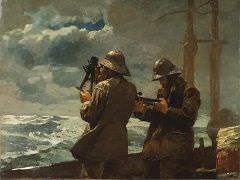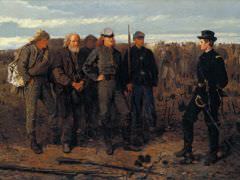Inside the Bar, 1883 by Winslow Homer

In 1881, Homer traveled to England on his second and final trip abroad. For reasons both personal and professional, he sought a place of retreat. After passing briefly through London, he settled in Cullercoats, a village near Tynemouth on the North Sea, remaining there from the spring of 1881 to November 1882. Situated on sandstone cliffs above a small bay, Cullercoats was a fishing community, which, like nearby Tynemouth, attracted artists and photographers in search of the picturesque. Homer soon became sensitive to the strenuous and courageous lives of its inhabitants, particularly the women, whom he depicted hauling and cleaning fish, mending nets, and, most poignantly, standing at the water's edge, awaiting the return of their men.
In Cullercoats, Homer worked almost exclusively in watercolor. On large sheets such as this one, he perfected traditional English techniques, laying out compositions with broad, overlapping washes of color. The seriousness of his art increased and his figures became more monumental and strongly modeled. He made a number of watercolors from his Cullercoats studies after his return home, including this grand example. In such watercolors executed abroad and back in the United States, the major theme of Homer's mature years evolved: the dramatic, and sometimes tragic, confrontation of people and nature.
Inside the Bar reprises the theme of women posed against the stormy ocean with vessels in the distance. It is large and thoroughly worked like all of Homer's most ambitious studio watercolors of the same period. Inside the Bar was the
most extravagantly praised of all of the watercolors Homer showed in 1883 and, indeed, became something of a benchmark in his art.
Observers were especially struck by the powerful figure of the woman, who seemed the very embodiment of resolute force. In these grand watercolors Homer had indeed reached a new phase in his art, one in which he asserted a greatly heightened awareness of
the possibilities of design, composition, color, and light. But more than that, what most sets them apart is their tendency toward idealization, both of the men and women they depict and, although not so obviously, of nature itself. In them Homer had
established an aesthetic stage upon which he could depict heroic figures engaged in dramatic action and, through them, convey serious and profound meaning.















